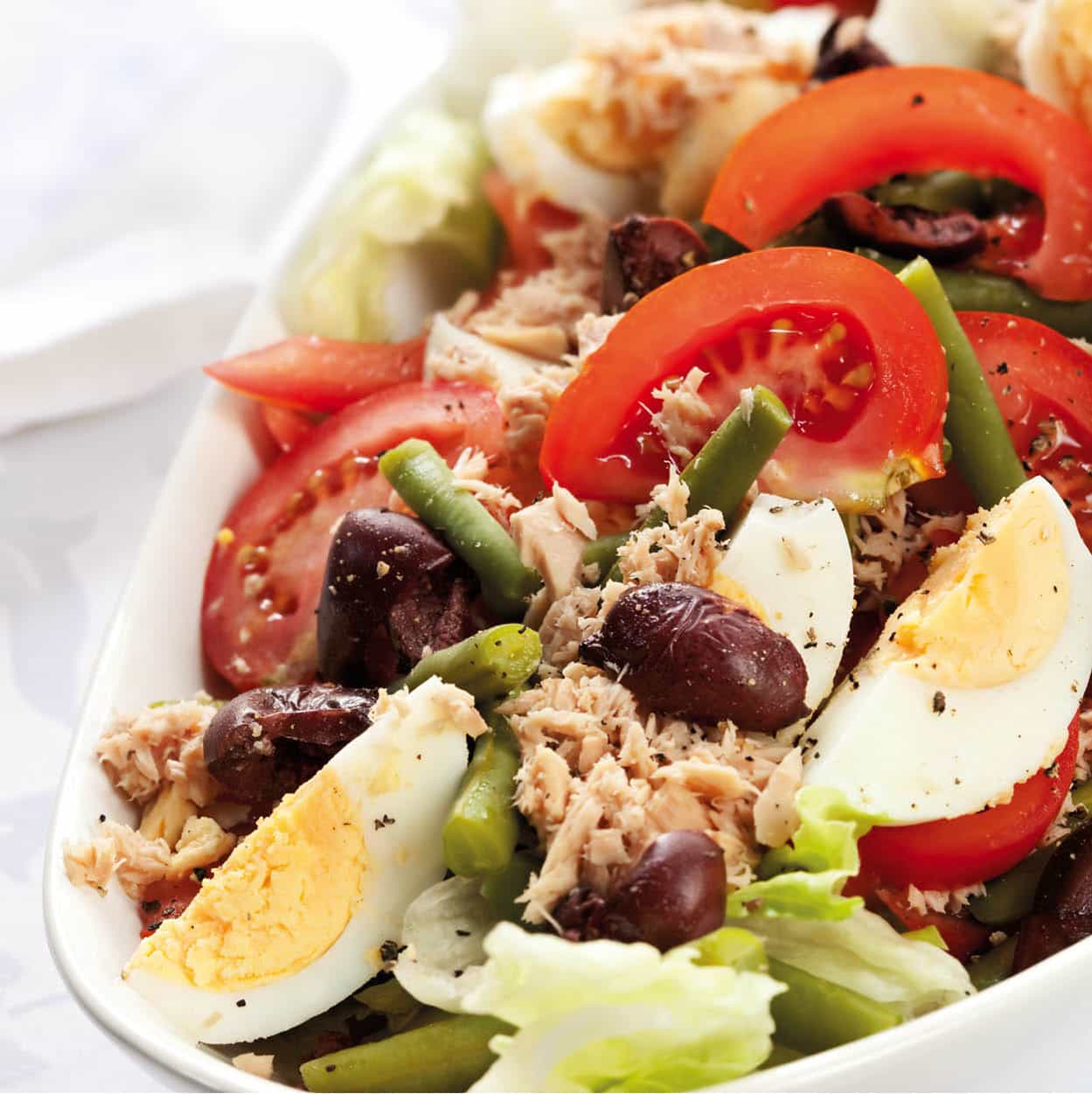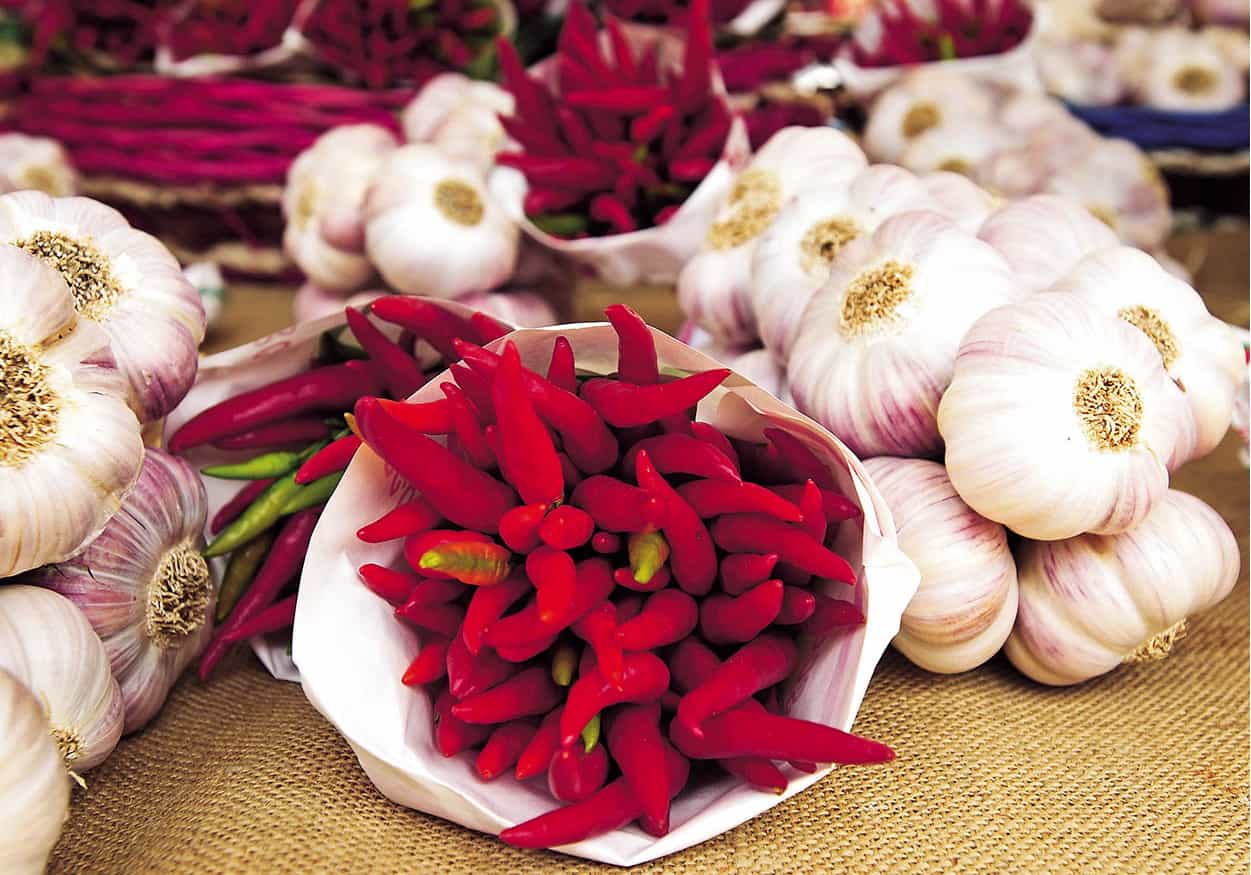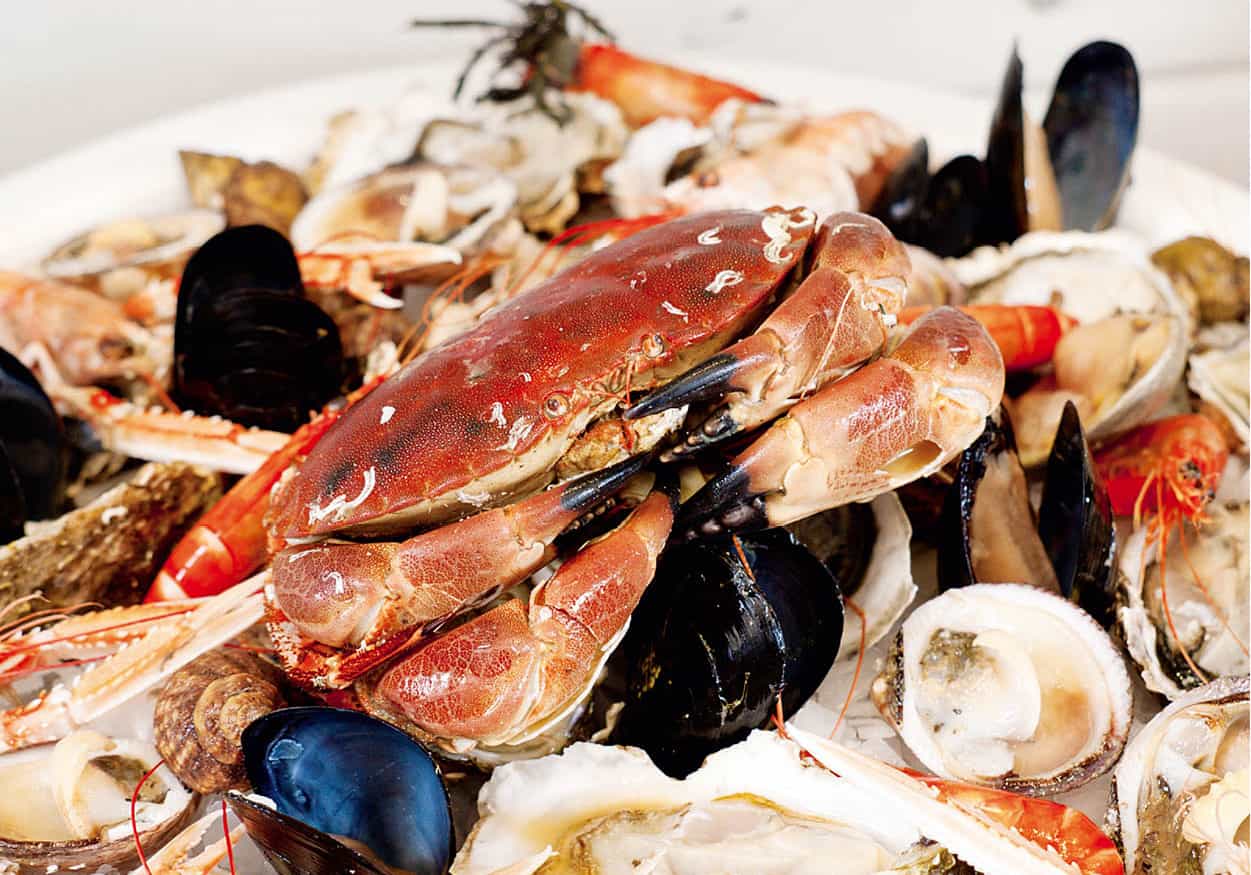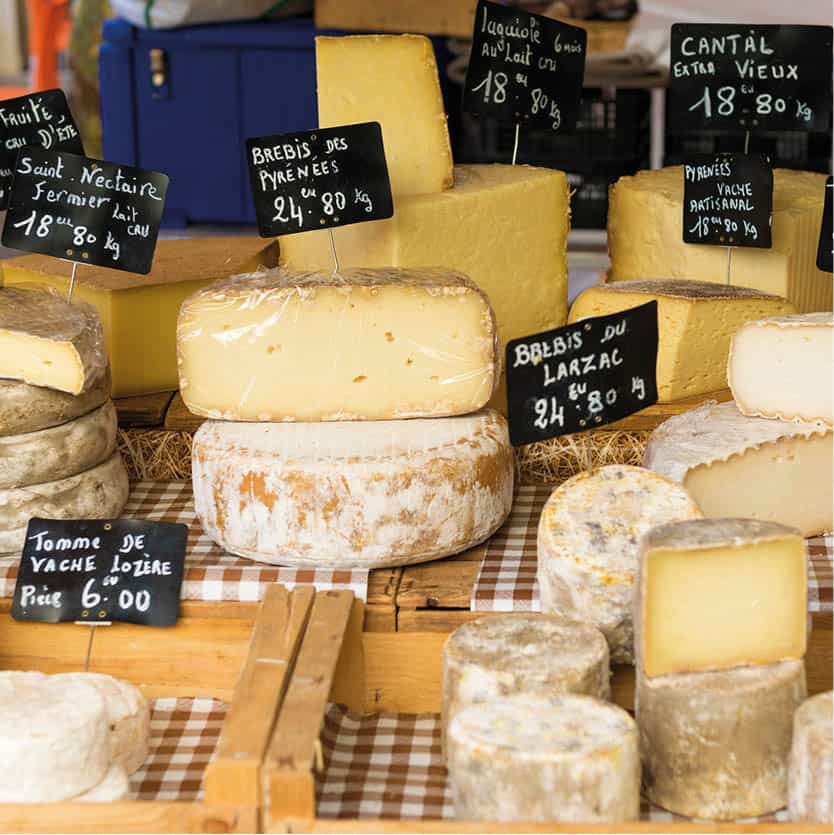The south of France’s exceptional local produce is at the heart of the cuisine here. Much of the best cooking is seasonal: asparagus in spring, tomatoes and courgettes in summer, tarts and gratins made with fresh figs in late summer, game, wild mushrooms and truffles in autumn.
Regional Specialities
Olive oil rather than butter is used for cooking and is a crucial ingredient in anchoïade (also known as bagna cauda), a warm anchovy and olive oil sauce, into which chopped raw vegetables are dipped, and aïoli (garlic mayonnaise), which usually appears as an appetiser dip.

Salade niçoise
iStock
Nice’s distinctive cuisine is a fusion of Provençal and Italianate influences resulting from the town’s Savoyard past and a long to-and-fro history between the two, as well as its market-gardening tradition. Some specialities, such as salade niçoise (salad with tuna, olives, peppers, green beans, eggs and anchovies) and ratatouille (a hearty, luscious mixture of tomatoes, onions, garlic, courgettes, peppers and aubergines), have travelled the world; others remain essentially local.
Nice claims to have invented ravioli, but here, unlike those found in Italy, they are typically filled with leftover daube de bœuf (beef stewed in red wine and herbs, cooked in a daubière) and swiss chard. Other Italianate specialities include gnocchi, made from potatoes or durum wheat, and soupe au pistou, a rich, minestrone-like vegetable and bean soup into which a sauce of basil, garlic and olive oil (pesto) is stirred at the end.
Nice’s cailletier olive turns up in many dishes; indeed, à la niçoise on a menu will often indicate a sauce made with tomatoes, onions and black olives, and may be found accompanying pasta, fish, chicken or rabbit.
Perhaps the most characteristic of all Niçois dishes, however, is petits farcis niçois, an assortment of stuffed tomatoes, aubergines, courgettes, onions and bell peppers, each with its own slightly different filling, based around ham, rice, herbs, minced meat and breadcrumbs.
Portable Treats
Snack food is an art form in Nice, where a whole range of specialities just seem designed for eating in the street. Socca, one of the legendary dishes sold at stalls in Vieux Nice (best-known are Chez René Socca at 1 rue Pairolière and Chez Thérésa in cours Saleya market), is a thin chickpea crêpe cooked on a large circular iron plaque, then cut up into portions, seasoned with black pepper, and best served very hot; pissaladière is a delicious open onion tart, garnished with anchovy fillets and black olives. Then there are panisses, deep-fried chickpea flour fritters, and ganses, mini doughnuts flavoured with orange blossom water and dusted with icing sugar, traditionally eaten during the Carnaval period. Even salade niçoise has its portable version, the pan bagnat: a crusty roll rubbed with garlic and olive oil and crammed with lettuce, tomato, onion, tuna and anchovies.
Vegetable Heaven
One area where Niçois and Provençal cuisine differ from the rest of France is the emphasis on vegetables, thanks both to the variety and quality of local produce and to peasant tradition where meat was mainly reserved for special occasions. Preparations can be as gloriously simple as marinated and roasted red peppers, or the fresh herbs and varied young salad leaves of delicate mesclun. Tomatoes are an ingredient in numerous sauces, but also appear as simple salads and chilled summer soups or as tomates provençales, a popular accompaniment to meat and fish dishes, sprinkled with minced garlic and breadcrumbs and baked very slowly until almost caramelised. Look out also for caponata, aubergine stewed with tomatoes and capers.

Peppers and garlic are two local staples
Sylvaine Poitau/APA Publications
You’ll also find all manner of vegetable tians, baked gratins of courgette, squash or aubergine with egg and rice, named after the rectangular earthenware dish in which they are cooked. Tiny purple artichokes, almost without a choke, are braised à la barigoule with mushrooms and bacon, but are also sliced very finely and eaten raw. Another treat is delicate orangey-yellow courgette flowers, dipped in egg and flour and deep-fried as fritters or stuffed with brousse (fresh cheese). Blettes (swiss chard) are served as a vegetable or combined with apples, raisins and pine kernels in Nice’s tourte de blettes, a surprisingly sweet tart; while stuffed cabbage, the leaves bound around a sausage-meat filling, is a rustic speciality of the Cannes and Grasse area.
Fish and Meat
Not surprisingly, given the Côte d’Azur’s glorious coastline and the trend for healthy eating, fish plays a large role, especially at beach restaurants and around the Vieux Port in Nice. However, overfishing of the Mediterranean and the decline of the Riviera’s fishing fleet mean that apart from the grandest restaurants, which still buy directly from the remaining local fishermen, much of the fish now comes from France’s Breton and Atlantic ports.

Fresh seafood is a regional speciality
iStock
Sardines are a speciality in Nice, stuffed with Swiss chard, marinated or grilled, as is estocaficada (stockfisch in Cannes, stocafi in Monaco), salt cod stewed in wine with tomatoes and olives. You’ll find the fish stew bouillabaisse (originally from Marseille) all along the coast, served in two courses, first the saffron-coloured soup accompanied by a garlicky rouille and then the fish and potatoes. Other typical preparations include sea bream baked with fennel and red mullet with basil, as well as grander dishes like sea bass baked in a crust of sea salt. For a brief period in spring look out for the local delicacy poutine, the tiny fry of sardines and anchovies fished with nets on the beach (now authorised only between 15 February and 31 March), which is prepared in soup, omelettes or fritters.
Meat is not forgotten, however – this is France. Almost every brasserie will have a steak frites on its menu, or a succulent Provençal daube de bœuf, stewed in red wine and herbs with a touch of orange zest. Rabbit is also commonly found, roasted with herbs or cooked à la niçoise with white wine, olives and tomatoes. The best lamb comes from the Alpine hinterland, notably Sisteron, while a more challenging Provençal classic is pieds et paquets, stuffed sheep’s tripe and feet stewed for hours in a tomato sauce.
Meal times
Lunch is served from noon–2.30pm and dinner from 7–10pm. The standard French meal consists of an entrée (starter), plat (main course) and dessert. Bread and a jug of tap water (carafe d’eau) with the meal will be served free on request. Most restaurants offer good-value set menus of two or three courses at lunchtime.
Cheese and Desserts
The Côte d’Azur is not a major cheese-making area, but you will find some mountain-style cow’s-milk cheeses from the Mercantour as well as goat’s cheese (chèvre), ranging from young, moist, fresh cheeses to harder, drier crottins. Among specialities are poivre d’âne, goat’s cheese rolled in summer savory, tiny cheeses marinated in olive oil and herbs, and brousse, a ricotta-like fresh cheese used in dips and desserts.
Desserts are mostly based around fruit, including figs baked in tarts, gratins and crumbles, and lemon meringue tart (tarte au citron meringuée) made with little lemons from nearby Menton. Fashionable desserts include summer-fruit soups and creations inspired by nostalgia for children’s caramel bars and strawberry sweets.
Where to Eat
Restaurants in France range from informal bistros with a convivial atmosphere, tightly packed tables and regional specialities, via modern gourmet bistros and fashionable designer venues, to grand haute-cuisine establishments, with superb cooking, starched linen and formal service.
Brasseries typically keep long hours – some serve all day – and have a lively atmosphere and a menu of classics, such as grilled fish and meat or gleaming platters of oysters and shellfish. There are also numerous Italian restaurants, ranging from popular pizzerias to authentic trattorias. At lunch, the French will often eat casually in a café, perhaps the plat du jour (hot dish of the day) or a salad, and even in smarter restaurants may opt for just a starter and main course or main course and dessert rather than all three.

Find French cheeses in the southern markets
iStock
Many restaurants in Vieux Nice and Le Suquet in Cannes remain firmly attached to tradition, with checked tablecloths and menus of regional specialities that don’t seem to have changed for decades, but, happily, southern cuisine continues to evolve. In Nice’s New Town, a growing number of chefs, often with an haute-cuisine background, are making adventurous use of regional produce and bringing in cosmopolitan influences. For instance, Keisuke Matsushima (for more information, click here), is Japanese and trained with Régis Marcon and the Pourcel twins, while Luc Salsedo worked at Alain Ducasse’s Le Louis XV (for more information, click here), and the Chèvre d’Or in Eze but has chosen to go for a market menu that changes every 10 days. At such places, you might find modern experimental preparations alongside a return to roots, with slow cooking in cast-iron casseroles.
Grand haute-cuisine establishments, such as Le Chantecler in Nice and Le Louis XV in Monte Carlo (for more information, click here), remain a pinnacle for special-occasion dining with luxurious ingredients and splendid settings, but Alain Llorca, formerly of Hôtel Negresco and the Moulin de Mougins, runs the Café Llorca (for more information, click here) in Monaco which has a bar and tea-room as well as a restaurant and even does take-aways.
A notable trend in Nice is for wine bars and wine bistros, where one feature is well-chosen wines available by the glass. Old-style wine bars concentrated largely on simple plates of charcuterie and cheeses, but the new breed often produce adventurous modern dishes but served in a less formal atmosphere than in conventional restaurants.
What to Drink
Something you’ll probably only ever see on a wine list in Nice are the rare Bellet wines, produced on the outskirts of the city. Most wine lists will also have a good choice from the rest of Provence, including Côtes de Provence, in all three colours; vast quantities of light, summery rosé; more substantial Bandol wines and the southern Rhône appellations – Côtes du Lubéron, Châteauneuf-du-Pape and Côteaux d’Aix-en-Provence. As well as 75cl bottles, wine bars will often have a good choice by the glass, while bistros may offer wines in 25cl or 50cl carafes.